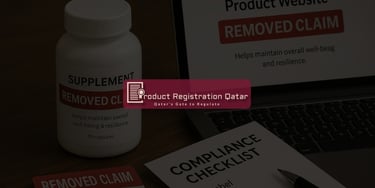Forbidden Product Claims in Qatar: Avoid MoPH Rejection
Learn the forbidden product claims in Qatar and how MoPH reviews labels, websites, and ads. Avoid rejection with compliant phrasing, evidence, and alignment.
BLOGS
10/17/20253 min read


Forbidden Product Claims in Qatar:
What Triggers MoPH Rejection — and Safer Positioning
In Qatar, claims drive approvals. A single word on your label, leaflet, website, or marketplace listing can trigger extra questions, re‑testing, or even MoPH rejection and import holds.
This guide explains how claims are interpreted, which patterns most often get blocked, and how to think about safer positioning so you keep control of approvals.
How MoPH Interprets “Claims”
Claims include text, icons, seals, images, before/after visuals, and ad copy tied to a specific SKU/GTIN.
Anything implying treatment, cure, prevention, or a physiological/therapeutic effect is considered high risk.
Digital channels count: brand websites, marketplaces, and social content linked to the product page are evaluated alongside the label.
Claim Categories That Commonly Get Blocked
Therapeutic & disease language: words like treats, cures, prevents, or naming conditions (e.g., diabetes, eczema).
Absolute outcomes: guaranteed results, works for everyone, or clinically proven without accepted evidence.
Medical endorsements: doctor/dermatologist recommended without compliant substantiation and context.
Children & sensitive populations: safe for all ages or blanket suitability without age/use qualifiers.
Visual exaggerations: extreme before/after imagery that suggests medical intervention or a drug‑like effect.
Claims strategy should be built around category rules and evidence—not stock phrases. The safest language flows from the approved dossier and the product’s real formulation.
Category‑Specific Pitfalls (Food · Supplements · Cosmetics)
Food & Functional
Disease‑lowering or drug‑like benefits.
Nutrition or fortification claims that don’t match the formulation or serving size.
Supplements
Deficiency/treatment statements that edge into medical therapy.
Dosage‑driven promises that imply a cure or prevention outcome.
Cosmetics & Personal Care
Acne/eczema treatment, hair regrowth, and hyperpigmentation cure.
Claims that move the product from a cosmetic into medicated territory.
Safer positioning mindset: Use precise, supportable benefits such as supports, helps, or contributes to, together with usage conditions, where appropriate and justified by evidence.
Arabic Phrasing Triggers to Watch
High‑risk medical verbs (e.g., يعالج / يمنع) raise red flags compared with functional phrasing like يساعد في / يدعم where suitable.
Keep Arabic and English fully aligned; avoid softening only in one language.
Ensure every claim in artwork, leaflets, and e‑commerce matches the approved scope and translation.
When Evidence Becomes Mandatory
Quantified or clinically proven claims invite requests for recognized studies, CoA/test reports, or compendial support.
Claims must match the dossier wording and formulation for the exact GTIN/SKU; gaps create queries or re‑evaluation.
Foreign‑language evidence often requires certified translation and, when needed, legalization for use in Qatar.
Pre‑Launch Claims Compliance Checklist (review points)
Cross‑check label, leaflet, website, and marketplace listings for consistency with the approved dossier and scope.
Remove disease/therapeutic terms; qualify benefits by age, frequency, and usage conditions where appropriate.
Verify Arabic ↔ English equivalence and ensure icons/seals are legitimate.
Synchronize GTIN/SKU, pack sizes, formulation specs, and approved claims across dossier, labels, and invoices.
Maintain a claims change log so that any wording updates trigger the right variation filing.
How We Help
Claim and label validation against MoPH expectations (Arabic & English).
Technical translation & legalization that preserves compliant meaning.
Dossier alignment across evidence, GTINs, and formulation; preparation of supportive documentation.
Advocacy to handle queries, negotiate acceptable re‑phrasings, and unblock flagged listings fast.
Frequently Asked Questions (FAQs)
Are “clinically proven” claims allowed in Qatar?
Yes—when backed by recognized studies and evidence relevant to the product and formulation, and presented within the approved scope.
Do marketplace listings have to match the approved label?
Yes. Online text tied to the SKU/GTIN is evaluated alongside the label; mismatches commonly trigger queries.
What evidence does MoPH accept for functional claims?
Category‑appropriate studies, CoA/test reports, and stability or safety data. Translation and, when needed, legalization are expected.
Can I mention a disease with a disclaimer?
Generally unsafe. Disease references are usually treated as therapeutic claims and can shift the product into a different regulatory pathway.
Do I need to re‑file if I change claim wording?
If the new wording changes meaning, scope, or risk profile, expect to file a variation before market use.
Recommended Reads
Qatar Labeling Rules for MoPH Product Registration
Key label elements and Arabic requirements to keep claims aligned.Post‑Approval Variations in Qatar: Labels, Formulas & Roles
When claim or label updates require filing a change.Top 7 MoPH Product Rejection Reasons in Qatar
The recurring mistakes that lead to refusals.See what really drives product registration costs in Qatar
fees, testing, and hidden multipliers—so you can avoid rework.How Qatar Customs & MoPH cross-checks catch HS/GTIN/label mismatches
and how to prevent shipment holds.
Final Thoughts
Claims are powerful—but in Qatar, they are also regulatory commitments. Build them on evidence, keep translations aligned, and make sure every channel reflects the approved scope.
Planning claims or updating listings?
Contact us or use the chatbot in the bottom‑right. We’ll validate wording, align dossiers and labels, and manage filings so you avoid rejections and import holds.
Ready to Ensure Your Product is Fully Compliant?
Fill out the form below and let our experts guide you through label checks, formula validation, and registration—step by step.


